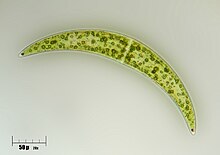
Chlamydomonadales, also known as Volvocales, are an order of flagellated or pseudociliated green algae, specifically of the Chlorophyceae. Chlamydomonadales can form planar or spherical colonies. These vary from Gonium up to Volvox. Each cell has two flagella, and is similar in appearance to Chlamydomonas, with the flagella throughout the colony moving in coordination.

Desmidiales, commonly called the desmids, are an order in the Charophyta, a division of green algae in which the land plants (Embryophyta) emerged. Desmids consist of single-celled microscopic green algae. Because desmids are highly symmetrical, attractive, and come in a diversity of forms, they are popular subjects for microscopists, both amateur and professional.

The Zygnemataceae are a family of filamentous or unicellular, uniseriate (unbranched) green algae. The filaments are septated and reproduction is by conjugation; Spirogyra is commonly used in schools to demonstrate this kind of reproduction. The family is notable for its diversely shaped chloroplasts, such as stellate in Zygnema, helical in Spirogyra, and flat in Mougeotia. The Zygnemataceae are cosmopolitan, but though all generally occur in the same types of habitats, Mougeotia, Spirogyra, and Zygnema are by far the most common; in one study across North America, 95% of the Zygnemataceae collected were in these three genera. Classification and identification is primarily by the morphology of the conjugation, which is somewhat rare to find in natural populations of permanent water bodies; when in the vegetative state, the rarer genera resemble the three most common, and are often mistaken for them and catalogued as such. Conjugation can be induced in low-nitrogen culture. While they occupy many habitats, in North America all are found solely in freshwater or subaerial habitats. Species typically exist as floating mats in stagnant water in ditches and ponds, but some also grow in moving water, attaching themselves to a substrate by rhizoid-like projections of the basal cells of the filament. The mat species rise to the surface in early spring, grow rapidly through the summer, disappearing by late summer. Members of the Zygnemataceae, such as Spirogyra, fall prey to parasites, especially chytrids. Most genera previously assigned to Mesotaeniaceae as well as the Desmidiales actually emerged in the Zygnematacae.

Selenastraceae is a family of green algae in the order Sphaeropleales. Members of this family are common components of the phytoplankton in freshwater habitats worldwide. A few species have been found in brackish and marine habitats, such as in the Baltic Sea.
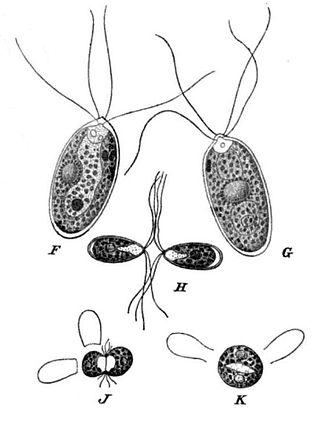
Carteria is a genus of green algae in the family Chlamydomonadaceae. Carteria are similar in morphology to the common genus Chlamydomonas and differ by having four, rather than two, flagella at the vegetative stage.

Desmodesmus is a genus of green algae in the family Scenedesmaceae. It is the only chlorophyll-containing organism known to have caused human infections in immunocompetent individuals. All known cases involved open injuries occurring in fresh water.

Lobomonas is a genus of green algae in the family Chlamydomonadaceae, found in freshwater habitats. Although it is widely distributed, it is a rare genus.
Marsupiomonas is a genus of green algae, containing a single species Marsupiomonas pelliculata.
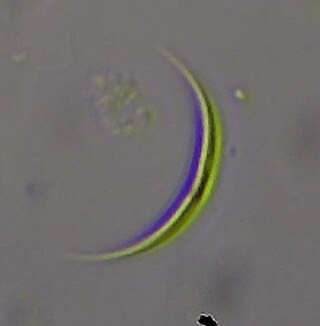
Monoraphidium is a genus of green algae in the family Selenastraceae. Monoraphidium is found free-floating or attached to surfaces in water, or in soils. It is one of the most common types of phytoplankton in freshwater habitats, and has a cosmopolitan distribution.
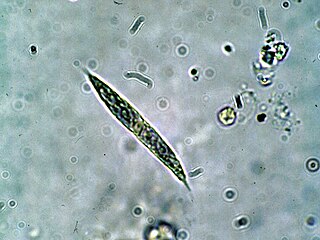
Quadrigula is a genus of green algae in the family Selenastraceae. It is commonly found in freshwater habitats as phytoplankton.
Raphidocelis is a genus of green algae in the family Selenastraceae. They are found in freshwater habitats.

Selenastrum is a genus of green algae in the family Selenastraceae. It is common in freshwater habitats around the world. Most species prefer temperate or warm-temperate waters.

Sorastrum is a genus of green algae in the family Hydrodictyaceae. It is a component of the phytoplankton of freshwater ponds, lakes, and ditches. Sorastrum is common in tropical to temperate regions of the world, but due to its small size it is often overlooked.
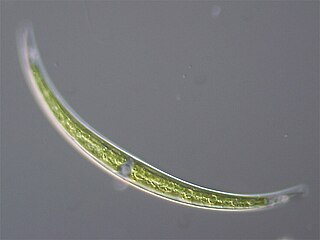
Closterium is a genus of desmid, a group of charophyte green algae. It is placed in the family Closteriaceae. Species of Closterium are a common component of freshwater microalgae flora worldwide.

Cosmarium is a genus of freshwater organisms belonging to the Charophyta, a division of green algae from which the land plants (Embryophyta) emerged.
Spinoclosterium is a genus of green algae, specifically of the Closteriaceae. It is rare, but widely distributed in freshwater regions throughout the world.

Triploceras is a genus of desmid in the family Desmidiaceae.
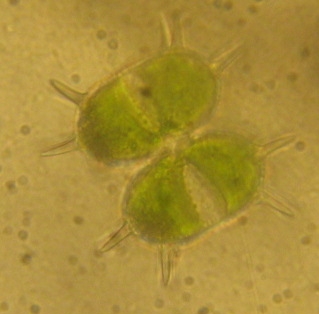
Xanthidium is a genus of green algae, specifically of the Desmidiaceae.

Zygnematophyceae is a class of green algae in the paraphylum streptophyte algae, also referred to as Charophyta, consisting of more than 4000 described species. The Zygnematophyceae are the sister clade of the Embryophyta.
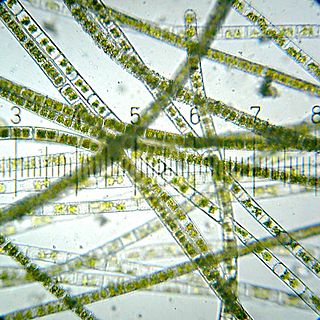
Zygnema is a genus of freshwater filamentous thalloid alga comprising about 100 species. A terrestrial species, Z. terrestre, is known from India. Zygnema grows as a free-floating mass of filaments, although young plants may be found anchored to streambeds with a holdfast. The filaments form a yellow-green to bright green colored tangled mat, and are composed of elongate barrel-shaped cells, each with two star-shaped (stellate) chloroplasts arrayed along the axis of the cell.
